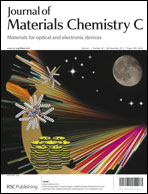Highly photo- and electroluminescent 1,3-diketonate Eu(iii) complexes with spiro-fluorene-xantphos dioxide ligands: synthesis and properties†
Abstract
Spiro-fluorene-xanthene-bis(diphenylphosphine) dioxide turned out to be a particularly effective co-sensitizer for Eu(hfa)3, Eu(tta)3 and Eu(nta)3 photoluminescent complexes. These ternary complexes proved to be particularly good materials for pure red color OLED devices. Two complexes, Eu(tta)3 and Eu(nta)3, were selected for OLED device testing. Surprisingly, these complexes displayed excellent performance within known Eu(III) complexes, as OLED materials. The electroluminescence (EL) spectra of Eu(tta)3SFXPO and Eu(nta)3SFXPO OLEDs show only Eu emission with a peak at 612 nm. The CIE coordinates are (0.65,0.32) for Eu(tta)3SFXPO OLEDs and (0.66,0.33) for Eu(nta)3SFXPO OLEDs, which means that the emission from these Eu-based OLEDs is pure red. At a brightness of 100 Cd m−2, Eu(tta)3SFXPO OLEDs have an external quantum efficiency of 2.4%, a power efficiency of 0.6 lm W−1 and a current efficiency of 3.2 Cd A−1. To our knowledge, this external quantum efficiency value is more than the best that has been previously reported for solution-processed Eu-based OLEDs at a brightness of 100 Cd m−2. More excitingly, Eu(nta)3SFXPO OLEDs shows an even better performance. At a brightness of 100 Cd m−2, Eu(nta)3SFXPO OLED possesses an external quantum efficiency of 3.7%, a power efficiency of 1.0 lm W−1 and a current efficiency of 5.1 Cd A−1. These OLED devices for testing were manufactured by a solution-processing method.


 Please wait while we load your content...
Please wait while we load your content...